Sustainable Use of Animal Slurries in Chile
Ortega Blu Rodrigo1* and Martinez Maria M1,2
1Universidad Técnica Federico Santa Maria, Chile
2Tropen- Inres, Universität Bonn, Germany
Submission: July 3, 2019; Published: July 26, 2019
*Corresponding author: Rodrigo Ortega Blu, Universidad Técnica Federico Santa Maria, Av. Santa Maria 6400, Santiago, Chile
How to cite this article: Ortega Rodrigo, Martinez Maria. Sustainable Use of Animal Slurries in Chile. Dairy and Vet Sci J. 2019; 13(2): 555857. DOI: 10.19080/JDVS.2019.13.555857
Abstract
Animal manure has good agronomic potential as fertilizer and / or soil improver. The slurry from animal production can be applied to the soil, either fresh or treated, after a treatment that can be completely aerobic, anaerobic or facultative aerobic. The most commonly used slurry comes from facultative aerobic lagoons or from biogas production plants. Each type of slurry has unique characteristics, which, in addition to the process, depend on the age of the animal, the type of feed, the amount of water used in the washing process, in addition to the type of washing (use of detergents or other cleaning substances). In the case of slurries coming from biogas plants, they are called digestates or biodigestates. Due to its high nutrient load, slurry can be used as fertilizer for crops, pastures, forest plantations, and fruit trees. The advantages that slurry has with respect to a chemical fertilizer source are its lower cost, and the positive effects caused on soil quality, given its organic matter (C), nitrogen (N) and phosphorus (P) contribution. However, like conventional chemical fertilizers, its application must be very careful, to maximize agronomic benefits and minimize the negative impacts that misuse could cause on crops, soil, water, and air.
Keywords: Slurry; Biodigestates; Nutrient; Fertilizer; Agronomic benefits; Waste valorization
Abbrevations: EC: Electrical Conductivity; BMP: Best Management Practices; FSMA: Food Safety Modernization Act; INM: Integrated Nutrient Management, DM:dry matter
Introduction
Nitrogen and Phosphorus are essential to life; however, the surplus of nitrogen or phosphorus used can leach or accumulates in soils or is spilled in water with negative environmental consequences [1-3]. Much losses from agroecosystems occur via leaching of mainly nitrate (NO3-) and via emission of gaseous N forms as ammonia (NH4) or nitrous oxide (N2O) [4]. Nitrogen, together with phosphorous present in manure or biodigestates, has an important agricultural potential, but its safe use depends of many conditions such nutrient content or management practices as applications techniques and precision agriculture [5,6], different soil tillage strategies [7] cover crops [8] or organic matter content and soil community [9].
The factors that must be considered for the correct dosage and application of slurry are: a. The quality of the slurry: The more stable and controlled the production process and the treatment of slurry, the more stable its physicochemical properties [14,15]. Table 1 shows the chemical characteristics of pig slurries of different origin from the central area of Chile. In Table 2, the characteristics of slurry from dairies in southern Chile are presented. b. The nutritional requirements of the crop: Each species has specific nutritional requirements. These are expressed in kg of nutrient per ton of product produced [10,11]. Part of these nutrient requirements are provided by the soil and the rest must be supplied through fertilizers, in this case slurry. Table 3 shows the nutrient requirements of selected crops in Chile. c. The properties of the soil: the physical and chemical properties of the soil, in particular, texture, pH, electrical conductivity, and the amount of available nutrients present, must be considered in order to properly estimate the rates of slurry [12,13]. d. The appropriate levels of nutrients: for fruit trees and crops are presented in Table 4. The electrical conductivity of the soil should ideally be <2 dS /m, although there are marked differences in salt tolerance among different species (Table 5). On the other side, the pH should remain above 5.8. e. Climate: climate controls the effectiveness of applications and directly affects the loss of gases and nutrients to the environment [15]. Normally, slurries should be applied in periods without precipitation and when the crop is in full growth so that it can take advantage of the nutrients applied. Surface applications should be avoided; slurries should be incorporated through soil cultivation or irrigation, in order to minimize the gaseous losses of ammonia [14].
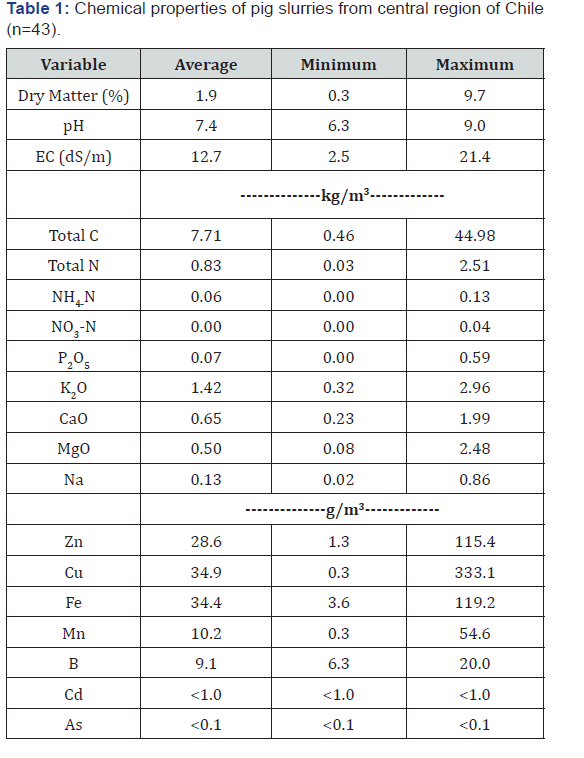
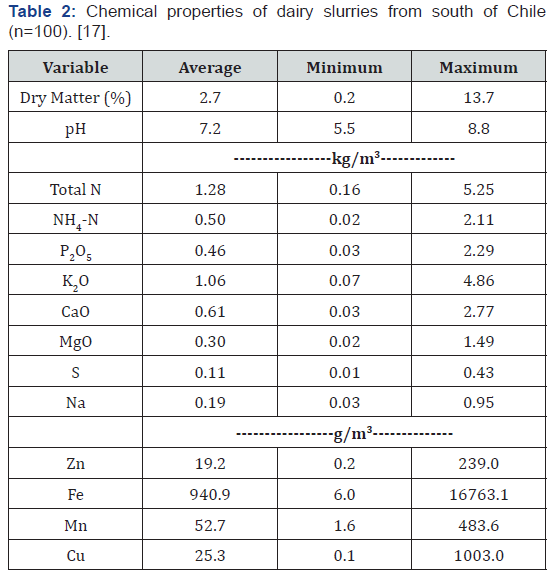

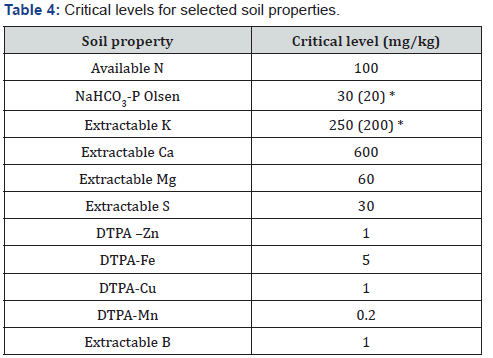
*number in parenthesis corresponds to extensive crops
How are the Rates of Slurry Determined?
There are numerous ways to estimate nutrients rates for a given crop. However, those that produce lower rates and that allow good yields should be preferred. For nitrogen (N), a balance is usually done, between the demand of the crop (Table 3) and the N supply, including the soil residual N, N contributed by irrigation water, and the one that will be mineralized during the season [3]. In the case of phosphorus and potassium, the recommendation criterion used is called construction + maintenance; in this, the idea is to build up to the critical levels and then keep them, replenishing only the crop extraction [6]. The extraction of nutrients from the crop is what comes out of the field in the product, approximately half of the demand. If one wants to be more conservative, it is possible to replenish the full demand. The rates of slurry will depend on the criteria used: a. Meet N needs of the crop b. Meet P needs of the crop c. Meet K needs of the crop

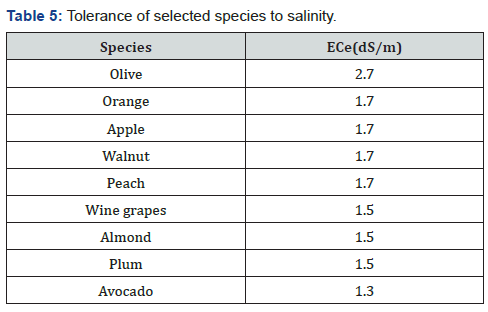
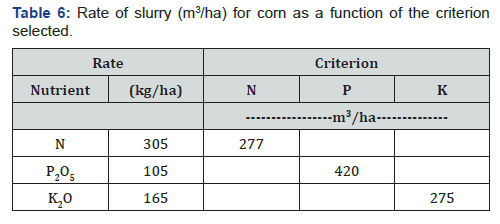
The slurry rate to be used should be the lowest one that satisfies the requirements of one of the nutrients, in particular N or P. The deficits of some nutrient should be provided with conventional fertilizers. Table 6 shows an example of rate estimation of slurry for corn yielding 15 ton/ha, using a slurry containing 1.1 kg N, 0.25 Kg P2O5 y 0.6 K2O/m3, respectively, and the above criteria. The rates of slurry could vary between 275 and 420m3/ha/season, depending on the criteria (Table 6). When the P criterion is used, N and K requirements are exceeded by more than 50%; whereas when N or K criteria are used, there is a shortage of P of about 34%. According to these results, the appropriate rate of slurry should be 275m3/ha/season, which would meet the needs for N and K, without excess. The deficit observed in the case of P, should be covered with conventional fertilizers sources (Table 7). Figure 1 shows the distribution of slurry rates for different crops, fruit trees (orchards), and pastures, considering a typical slurry composition. It is observed that the smaller rates correspond to fruit trees, while the larger ones to crops and pastures. On average, rates of 100m3 / ha for fruit trees and 160m3 / ha for extensive crops should be applied.
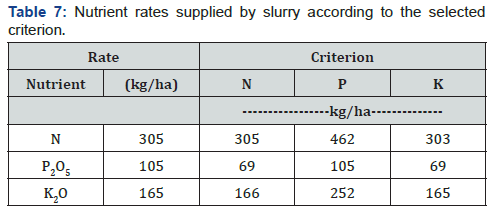
How are Slurries Applied?
Slurries should be applied incorporated to the soil at the end of winter in extensive crops without controlled irrigation, or diluted through irrigation, either by sprinkling, micro sprinkling or dripping [14]. As with conventional chemical fertilizers, they must be diluted sufficiently, in order not to exceed the electrical conductivity (EC) that could affect the crop. Normally, with the diluted slurry should not exceed 2 dS/m, therefore it should be diluted 10 times, that is, for each cubic meter of slurry, 9m3 of irrigation water should be applied. For example, in a typical irrigation of 80m3 of water / ha, about 9m3 of slurry could be applied.
Quality of slurries and Food Safety
The slurry applied must be harmless to human health and must comply with established standards. Chilean Standard 3375 establishes the following values as indicators of biological contamination in slurries and biodigestates: E. coli (<1000 NMP / g DM), Salmonella sp. (<3 NMP / 4 g DM), helminth eggs (<1/4 g MS). The same standard establishes the maximum limits of heavy metals: AS (55 mg / kg), Cd (15 mg / kg), Cu (667 mg / kg), Cr (167 mg / kg), Hg (3 mg / kg) , Ni (133 mg / kg), Pb (367 mg / kg), Zn (1333 mg / kg). The recent the Food Safety Modernization Act (FSMA) - USDA of the United States, which regulates in greater detail the use of water, organic fertilizers and agricultural inputs, should be considered when using slurry.
What soil and water Indicators should be Evaluated when Applying Slurry?
The analysis of soil and groundwater is very important to determine the correct application of slurry. The pH and EC of the soil, its levels of available N and P, as well as the contents of heavy metals, should be monitored to evaluate their possible accumulation. In the case of groundwater, this must have contents of NO3-N <10 mg / L and PO4-P <0.03mg / L.
Conclusion
Slurries and biodigestates from animal manure are an excellent source of organic matter and nutrients for agriculture. However, for using slurries in a sustainable and safety way, the best management practices (BMP) must be followed, similar to those used for conventional nutrient sources and include many different aspects as the target crop nutrient requirements, soil properties, season and climate. Integrated Nutrient Management (INM) is the ideal framework to maximize the agronomic and environmental benefits of the application of slurry and biodigestates
Conflict of Interest
The authors declare that they do not have any economic interest or conflict of interest.
Acknowledgment
ASPROCER, in particular to the PYME Porcina Project for the data regarding pig slurry.






























